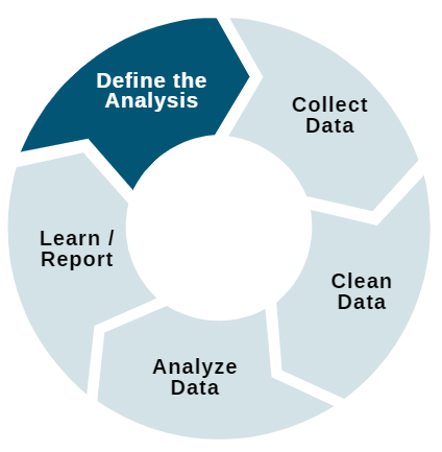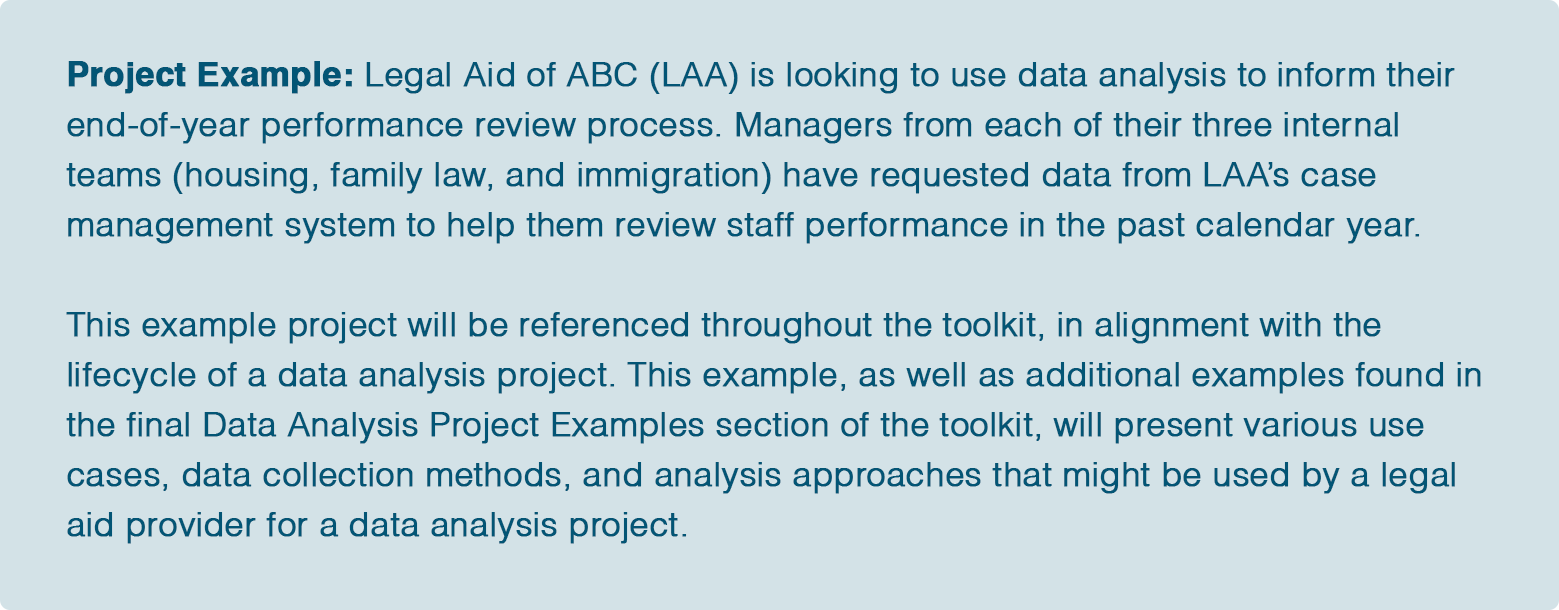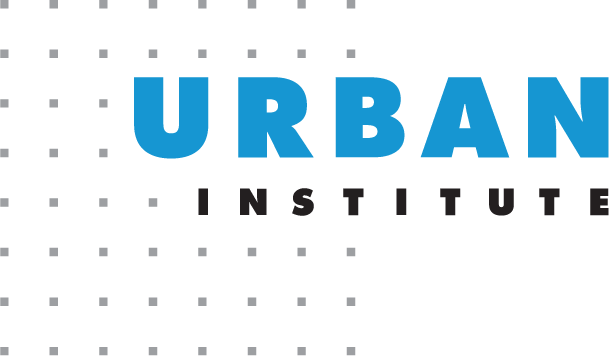- 1. Data & Evaluation Toolkit: Overview of Data Analysis Projects
- 2. Data & Evaluation Toolkit: Defining the Analysis
- 3. Data & Evaluation Toolkit: Collecting the Data
- 4. Data & Evaluation Toolkit: Preparing and Analyzing the Data
- 5. Data & Evaluation Toolkit: Presenting and Learning from the Data
- 6. Data & Evaluation Toolkit: Building a Strong Data Culture
- 7. Data & Evaluation Toolkit: Overview of Evaluations
- 8. Data & Evaluation Toolkit: Data Analysis Project Examples
- 9. Data & Evaluation Toolkit: Acknowledgments
1. Data & Evaluation Toolkit: Overview of Data Analysis Projects


What resources are needed for a data analysis project?
Data sources, analysis techniques, costs, and resource needs will vary depending on the project. But at its core, every data analysis effort boils down to just a few components:
- A Key Question: This is the heart of the project, establishing what the learning objectives are from the data analysis effort. It is important that the question is actionable; at the project onset, there should already be an idea of how results may be used to impact the organization.
- A Dataset: An analysis can utilize existing data from public sources, case management systems, free web analytic tools, and more. New data can be collected by adding questions fields to existing processes, surveying users, conducting interviews, and other methods.
- Tools to Prepare, Analyze, and Display Data: There are countless free and low-cost tools to use for these purposes, such as Google Data Studio, Microsoft Excel and Power Bi, and Tableau. Some entities, such as Tech Soup, provide discounts on related software to nonprofit organizations.
- An Individual or Team to Process the Data: This work does not always require a formally trained data analyst or a paid external consultant. Depending on complexity, an existing staff member, local volunteer, college intern, or academic institution might be able to carry out the analysis.
- An Engaged Audience: Keep the audience in mind throughout every step of the project. Be sure to consider the audience’s level of data literacy and intended use of results when presenting results.
A data analysis project can be made more complex by incorporating multiple questions, datasets, tools, or audiences. It is not always necessary to do so – even the simplest of data analysis projects can yield insightful findings that have an outsized impact on a decision. No matter the scale of the effort though, it is important to always make sure the data analysis project is accurate, ethical, and actionable.
When should an organization engage in a project involving data analysis?
Put simply, an organization is ready to start engaging in data analysis work once it has identified a key question and an audience. Organizations should not begin a data analysis project until they have defined their key question, as this helps to narrow the scope of the project and prevent collecting data with no clear use. This question informs what data will be needed and what analysis and presentation strategies will be deployed.
Identifying the intended audience at an early stage will also help to limit the scope of the project and inform how results should be presented. Depending on the project, data analysis may be the sole source of information used to address a question, or it may be just one of many inputs (e.g., conversations with experts, historic precedents, availability of funds, etc.) that factor into a particular decision.
After selecting the key question and audience, an organization may need additional time to acquire funding, staff, and/or data to complete the data analysis effort. But when it comes to using data to inform a decision, this work should not be written off as too expensive or technically complex until the key question and audience are identified. The related data and resources needed to compile insightful results may already be on hand or easily attainable.
What is the lifecycle of a data analysis project?
Data analysis efforts follow these five steps:
- Define the Analysis: Determine what question(s) to answer, who wants the answer, and why it needs answering. This will shape the goals, methods, and presentation of the analysis.
- Collect Data: Identify accurate, relevant data points that will help answer the key question. Implement sound collection practices to acquire any new data needed for the analysis.
- Prepare Data: Review the dataset to ensure correct, complete data. Reformat data as needed to make for easier analysis and visualization.
- Analyze Data: Make use of the numerous techniques available to describe and analyze the data, to detect patterns, trends, and insights that relate back to the key question.
- Present and Learn from the Analysis: Display insights and trends that relate directly to the key question. Make sure results are clear, self-explanatory, and tailored to audience needs.
Data analysis projects do not always end with this last step. Some projects may result in ongoing monitoring or further analysis. Results from other projects may spur new key questions that can be addressed using additional data analysis. Rather than a straight line with a clear start and stop, the data analysis lifecycle is often more a continuous circle, as illustrated below:

Each of the five steps are reviewed in more detail in separate sections of this toolkit. Continue to the next section to learn more about identifying key questions and how they influence all parts of the data analysis project.

How does equity relate to data analysis?
When there is data, there are equity implications. Equity and ethics are important to consider at every stage of the data analysis project lifecycle, such as:
- Will data collection or analysis impact historically marginalized and vulnerable populations? If yes, what efforts will be taken to reduce harm and address burden?
- How will demographic data be collected and used?
- Which methods and languages will be used for data collection?
- How will data collections methods be accessible (e.g., surveys, focus groups, interviews, etc.)?
- How will results be accessibly presented?
- How will results be disseminated back to involved communities and individuals?
Fortunately, there are many organizations that are doing great work on building data equity literacy, such as:
 |
The Data Equity Framework and other tools provide a robust approach to equity-focused data analysis.The Talking Data Equity series provides ongoing opportunities to learn more. |
 |
Check out the Why Am I Always Being Researched guidebook to learn more on an equity-based, community-driven approach to research and analysis. |
|
|
This group maintains a comprehensive list of resources for developing and elevating data equity practices. |
| These resources are highly recommended to build a more robust understanding of what it means to have an equity-focused approach to data analysis work. | |
- Prev
- Next




